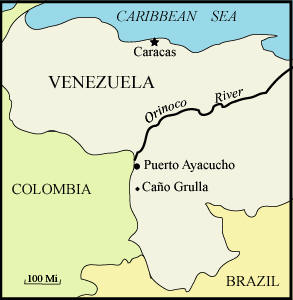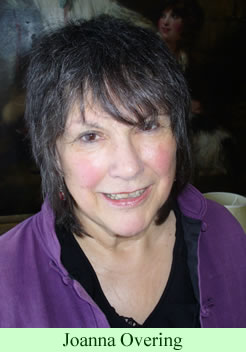A Venezuelan news story last week suggests the possibility that traditional Piaroa aesthetic values, essential aspects of their peacefulness, may be spread more widely in coming years.
 The Venezuela Symphony Orchestra, La Orquesta Sinfónica de Venezuela (OSV), visited a Piaroa village, Caño Grulla, on February 15 and 16 as part of its “OSV at My School” program. The outreach effort by the orchestra into the Piaroa community, located 60 miles south of Puerto Ayacucho, the capital of Amazonas State in southern Venezuela, kicks off its celebration of the nation’s bicentennial of its declaration of independence.
The Venezuela Symphony Orchestra, La Orquesta Sinfónica de Venezuela (OSV), visited a Piaroa village, Caño Grulla, on February 15 and 16 as part of its “OSV at My School” program. The outreach effort by the orchestra into the Piaroa community, located 60 miles south of Puerto Ayacucho, the capital of Amazonas State in southern Venezuela, kicks off its celebration of the nation’s bicentennial of its declaration of independence.
Alejandro Montes de Oca, President of the orchestra, indicated at a press conference last week in Caracas that the visit was to be sponsored by the Ministerio del Poder Popular para la Educación. The purpose of the visit was to encourage an appreciation for orchestral music by having the musicians interact and perform in small groups in the classes with the teachers and students.
In addition to bringing their instruments and music into the classrooms, the orchestra hoped to learn from the visit about the indigenous musical traditions of the Piaroa. A brass quintet and a string quartet from the orchestra were slated to give concerts in the community. The concerts were to be recorded for later production as audio and video documentaries. The orchestra has been increasing its visits to schools as part of its outreach program.
The most intriguing aspect of the news story is the statement that the orchestra will be seeking to learn about Piaroa musical traditions. Pioneering European composers such as Béla Bartók started visiting the villages of Hungary and Romania about 100 years ago to study their indigenous music and to then create profoundly inspiring compositions. Many other composers have done the same thing.
It is not clear from the press release and the news story if anyone will follow up the visit by the orchestra and really study Piaroa music, but one can hope that contemporary composers in South America, and elsewhere, might appreciate the meanings of their music and create new compositions based on it.
Stanford Zent (1994) indicates that Piaroa music consists basically of singing by the traditional shamans. “The songs are composed of an archaic language form stylized by metaphor and set to musical cadence and pitch,” he writes.
 Joanna Overing (1989b) gives a much more detailed overview of the aesthetic values of the Piaroa and how they relate to their peaceful society. She writes that the Piaroa traditionally conflated their aesthetic values and their attitudes toward the production of economic goods. Production is either social or antisocial, they believe, and thus it is either beautiful or ugly. Controlled behavior is beautiful and conducive to the formation of community, while excess is opposed to community and is ugly. Beauty is therefore a moral conception. Piaroa aesthetic values reflect, and influence, their social and economic lives.
Joanna Overing (1989b) gives a much more detailed overview of the aesthetic values of the Piaroa and how they relate to their peaceful society. She writes that the Piaroa traditionally conflated their aesthetic values and their attitudes toward the production of economic goods. Production is either social or antisocial, they believe, and thus it is either beautiful or ugly. Controlled behavior is beautiful and conducive to the formation of community, while excess is opposed to community and is ugly. Beauty is therefore a moral conception. Piaroa aesthetic values reflect, and influence, their social and economic lives.
Overing argues that aesthetic knowledge enables the Piaroa to create their sense of community. The ability of the individual to maintain harmony with others is the essence of Piaroa aesthetics. They associate beauty with fertility, abundance, moderation, cleanness, restraint, and social and moral goodness. They associate ugliness with excess, madness, dirt and antisocial behaviors. [The present tense is used here, even though Piaroa beliefs may have changed in the 22 years since Overing’s article was published.]
The people connect their positive and negative aesthetic and social values with their uses of the resources of the earth. The negative qualities that they abhor—arrogance, a quarrelsome personality, greed, madness—are all produced by an inability to keep productive forces under control. Excessive use of natural resources, plus illegitimate political and social power, are all the result of antisocial evil forces.
The Piaroa recognize that they face a dilemma. They clearly have to use natural resources. They need to rely on their predatory abilities, as they see them, to garden, hunt, and transform plants into edible foods. Thus, their productive capabilities contain the seeds of violence and ugliness. The healing song of the shaman is also, potentially, the breath of the jaguar. The beads of life contain poisonous predatory forces. However, with the help of the shamans, the cleansing powers of the moon allow the Piaroa to overcome their dangers and expel poisons and wildness from the forces of production.
Their aesthetic works, such as the songs of their shamans and their art, clean, beautify, and civilize their productive use of natural resources. This cleansing gives them the ability to make personal moral decisions, to choose virtuous actions. Beauty for the Piaroa is thus a social skill tied to emotional control and reason: proper social and productive behavior becomes beautiful through control and correct action.
Piaroa values may have changed in today’s world, of course, under the influence of Christian conversions and modernizing forces. Time will tell if the visit of a national orchestra to a Piaroa village will transmit any of the traditional Piaroa musical and aesthetic values to a wider audience.